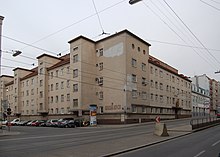Alexander Popp (architect)
Alexander Popp (born August 10, 1891 in St. Leonhard am Forst ; † December 7, 1947 in Linz ) was an Austrian architect , builder and furniture designer .
Live and act
Popp and his twin brother were the youngest children of a nationally minded merchant family. After graduating from the State Trade School (Baufach) in Vienna in 1911, he worked for the building department of the First Danube Steamship Company for which, after his military service (1912 to 1919), he was the chief commissioner for station buildings along the Danube, warehouse and hall buildings, workers 'and officials' houses planned and implemented. In 1915 he married Margarete Samper.
Popp was a student and assistant to Peter Behrens at the Vienna Academy of Fine Arts and was in his shadow throughout his life and in professional competition with Clemens Holzmeister (for example at the Wiener Funkhaus ). From 1924 Popp was a member of the Central Association of Architects in Austria . From 1924 to 1929 he worked as a designer for the Odol brand . His commitment to furniture design was supported by private commissions from friends and relatives of his mother and concentrated on the Upper Austria area . In 1930 he was appointed associate professor at the Academy of Fine Arts. Popp earned his reputation as an industrial architect primarily through the construction of the tobacco factory in Linz ( shared office with Peter Behrens) and, after the National Socialists came to power, through building halls for the Reichswerke Hermann Göring (1939 to 1944).
Popp was a member of the Fatherland Front and from 1935 a member of the NSDAP . From 1936 to 1938 Popp was President of the Vienna Secession . In 1938 he was appointed provisional director of the Vienna Academy together with Ferdinand Andri and Wilhelm Dachauer and head of a master school. From 1941 to 1945 Popp was rector of the academy.
At the end of the war in 1945, Popp was relieved of all his offices. In 1947 his dismissal as professor and rector was lifted.
Popp spent the last years of his life in Nussdorf am Attersee . He died of a pulmonary embolism in the Linz General Hospital .
Buildings (excerpt)
- Tobacco factory (Linz) with Peter Behrens for the Austrian tobacco control , built between 1929 and 1935.
- Various residential complexes in the residential building program of the Vienna community during the interwar period, see list of Viennese community buildings , including:
- Albert-Sever-Hof : Municipal housing in Vienna with 96 apartments, 16., Maroltingergasse 56–58, built in 1930/31.
- Friedenskirche in Linz, with Peter Behrens, Hans Feichtlbauer and Hans Foschum , built between 1933 and 1951
- Building of the Upper Austrian Medical Association in Linz, built between 1937 and 1939
- Pioneer Monument Linz ( Ernst-Koref -Promenade), with sculptor Wilhelm Frass , built in 1935
Web links
- Alexander Popp. In: Architects Lexicon Vienna 1770–1945. Published by the Architekturzentrum Wien . Vienna 2007.
- "Alexander Popp" on linz.at.
- Literature by and about Alexander Popp in the catalog of the German National Library
Individual evidence
- ^ Hermann Steindl: The tobacco factory Linz. An icon of modern industrial architecture. Linz 2010, ISBN 978-3-200-01903-4 , p. 52.
- ↑ Andrea Bina: Alexander Popp: Builder and Architect. In: Tabak Fabrik Linz. Art architecture working world. Verlag Anton Pustet, Museums of the City of Linz 2010, ISBN 978-3-7025-0633-9 , p. 134 f.
- ^ A b Andrea Bina: Alexander Popp: Builder and Architect. In: Tabak Fabrik Linz. Art architecture working world. Verlag Anton Pustet, Museums of the City of Linz 2010, ISBN 978-3-7025-0633-9 , p. 136.
| personal data | |
|---|---|
| SURNAME | Popp, Alexander |
| BRIEF DESCRIPTION | Austrian architect |
| DATE OF BIRTH | August 10, 1891 |
| PLACE OF BIRTH | St. Leonhard am Forst |
| DATE OF DEATH | December 7, 1947 |
| Place of death | Linz |


